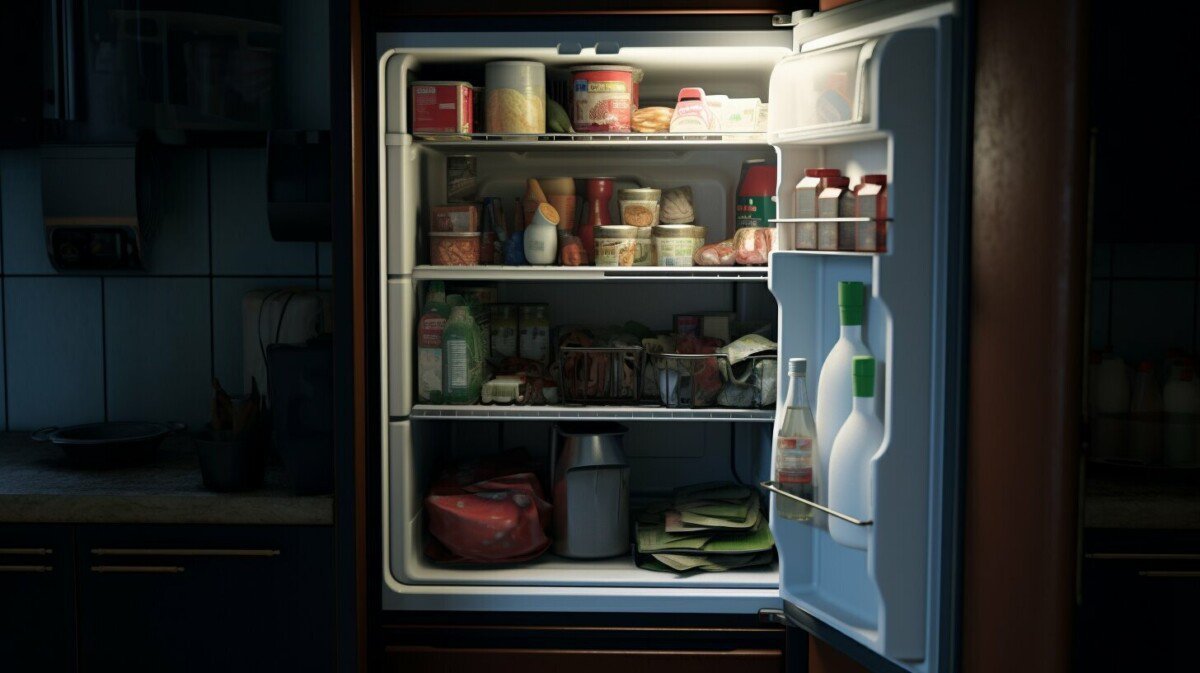Is your fridge not cooling? This can be a frustrating issue to deal with, especially if it happens unexpectedly. Luckily, there are many troubleshooting steps you can take to try and fix the problem yourself. In this article, we will provide you with expert solutions to help troubleshoot your fridge when it’s not cooling.
Some common issues you may encounter include your fridge not being cold, or not getting cold after a power outage. Don’t worry, we’ve got you covered. Keep reading to learn more about how to resolve these issues and get your fridge back to its optimal cooling capacity.
Check the Temperature Settings
If you notice that your fridge isn’t cold enough, the first thing you should do is check the temperature settings. The ideal temperature for a fridge is between 35-38°F (1.6-3.3°C). If the temperature is higher than this, your food may not last as long and could spoil.
Here’s how to check the temperature settings:
| Steps | Instructions |
|---|---|
| Step 1 | Locate the temperature control dial, which is usually located in the back of the fridge or inside the fridge compartment. |
| Step 2 | Check the current temperature setting and adjust if necessary. If the setting is too high or too low, adjust it accordingly. |
| Step 3 | Wait 24 hours to see if the new temperature setting has made a difference in the cooling efficiency of your fridge. |
If your fridge still isn’t cooling properly after adjusting the temperature settings, it’s time to move on to the next troubleshooting step.
Clean the Coils
One of the most common reasons for a fridge not cooling is dirty coils. Over time, the coils on the back or bottom of your fridge can become caked with dust and debris, hindering their ability to release heat. This can cause your fridge to work harder than it needs to, leading to decreased cooling performance.
To clean the coils, first unplug your fridge. The coils can be located either on the back of the fridge or underneath. Use a vacuum cleaner or a coil cleaning brush to gently remove any debris from the coils. You can also use a damp cloth to wipe them down. Be careful not to bend or damage the delicate fins on the coils.
After cleaning the coils, plug your fridge back in and give it a few hours to see if the cooling performance improves. If your fridge still isn’t cooling properly, there may be another issue at play.
Check the Door Seals
The door seals on your fridge play a crucial role in maintaining the temperature and preventing warm air from entering the fridge. If the door seals are not functioning properly, your fridge may not cool effectively, and you may notice that it’s not as cold as it should be.
To check the door seals, close the fridge door on a piece of paper or a dollar bill. If you can easily pull the paper or bill out, it’s a sign that the door seals are not airtight. You can try cleaning the seals with warm, soapy water and then drying them thoroughly. If this doesn’t improve the seals’ effectiveness, you may need to replace them.
It’s important to maintain the door seals properly to ensure they last as long as possible. Avoid using sharp objects to remove any debris from the seals, and don’t pull on the seals when opening the fridge door. These can cause damage and impact the effectiveness of the seals.
Check the Condenser Fan
If your fridge isn’t cooling after a power outage, it’s possible that the condenser fan is not working properly. The condenser fan is responsible for circulating air over the compressor and condenser coils, which helps to cool the fridge.
To check if the condenser fan is working, locate it at the back of the fridge. You should be able to hear it running when the fridge is cooling. If you don’t hear it running, try spinning the fan blades. If they don’t spin easily, the fan may be clogged with debris or defective and will need to be replaced.
If the fan blades spin easily, check the fan motor with a multimeter to ensure it’s getting power. If it’s not, you may need to replace the fan motor or the control board that powers it.
Check the Evaporator Fan
If your fridge is not cooling, the evaporator fan might be the culprit. The evaporator fan is responsible for circulating the cold air throughout the fridge.
To check if the evaporator fan is working, open the freezer door and look for the fan. If it’s not turning, it may be blocked by some debris or it could be malfunctioning. Try cleaning the fan blades and see if that fixes the issue. If the fan still doesn’t turn, it may need to be replaced.
If the evaporator fan is working, but there’s still no cool air in the fridge, there may be an issue with the airflow. Check if there are any obstructions blocking the air vents in the fridge. You may also try adjusting the temperature settings to see if that helps.
How to Clean the Evaporator Fan
Cleaning the evaporator fan is a simple process. Here’s how:
- Unplug the fridge from the power source.
- Locate the fan behind the back panel of the freezer.
- Remove the back panel by unscrewing it or sliding it out.
- Use a soft-bristled brush or a cloth to gently clean the fan blades and the surrounding area.
- Replace the back panel and secure it with screws or by sliding it back into place.
- Plug the fridge back in and turn it on.
If cleaning the evaporator fan doesn’t solve the issue, it may be time to call in a professional for further troubleshooting.
Check the Compressor
If your fridge is not cooling and you’ve checked all the other components, it might be an issue with the compressor. The compressor is responsible for compressing the refrigerant gas and circulating it through the cooling system. If the compressor isn’t working properly, the fridge won’t be able to cool down.
To check if the compressor is working, you’ll need to listen for it running. If you don’t hear any noise coming from the compressor, it may be the cause of the problem. However, if you hear a clicking noise, it could mean that the compressor is trying to start but can’t.
| Problem | Possible Solution |
|---|---|
| The compressor isn’t running | Check the power connections to the compressor. If they’re loose, tighten them. If they’re damaged, replace them. |
| The compressor is running but the fridge still isn’t cooling | The compressor might be overworked or damaged. In this case, it’s best to call a professional to repair or replace the compressor. |
Keep in mind that compressors can be costly to repair or replace, so it’s important to consider the age and condition of your fridge before investing in a new compressor.
Defrost the Fridge
If your fridge is not cooling but your freezer is working properly, it may be time to defrost your fridge. Over time, frost can build up on the evaporator coils, which can reduce the airflow and cooling effectiveness of your fridge. Defrosting your fridge can help to eliminate any built-up frost and improve its cooling ability.
To defrost your fridge, follow these steps:
- Turn off your fridge and unplug it from the electrical outlet.
- Remove all items from your fridge and freezer.
- Place towels or a large container underneath your fridge to catch any water that may melt during the defrosting process.
- Leave the doors open and allow the frost to melt naturally. You can also use a hairdryer or a fan to speed up the process.
- Once all the frost has melted, clean the inside of your fridge and freezer with a mixture of warm water and mild detergent.
- Wipe down all surfaces and dry them thoroughly.
- Plug your fridge back in and allow it to reach its operating temperature before placing any food items back inside.
If defrosting your fridge doesn’t solve the issue of it not cooling properly, it may be time to move on to other troubleshooting steps.
Check the Thermostat
If your fridge is not cooling properly, one possible cause could be a faulty thermostat. The thermostat is responsible for regulating the temperature inside your fridge, so if it’s not functioning correctly, it could be preventing your fridge from getting cold enough.
To check your thermostat, start by unplugging your fridge. Then, locate the thermostat control inside your fridge and turn it to the coldest setting. Wait for 10-15 minutes and then use a thermometer to check the temperature inside your fridge.
If the temperature is still warmer than it should be, you may need to replace the thermostat. Before doing so, make sure to consult your fridge’s user manual or contact a professional for assistance.
Check the Electrical Connections
If your fridge is not cooling, it’s important to check the electrical connections to ensure they are working properly. Faulty connections can prevent the fridge from receiving power, which can cause it to stop cooling.
To check the electrical connections, start by unplugging the fridge from the power outlet. Next, remove the access panel on the back of the fridge to inspect the connections. Look for any loose or damaged wires, and ensure they are securely attached to their respective terminals.
If you notice any loose or damaged wires, carefully tighten or replace them as needed. Be sure to turn off the power and unplug the fridge before doing so.
If the electrical connections appear to be in good condition, you may want to consider calling a professional to inspect and repair the electrical system of your fridge.
Check for Refrigerant Leaks
If your fridge is still not cooling after checking all the other potential issues, it might be a refrigerant leak. Refrigerant is the substance that cools the air inside your fridge and circulates through the coils. If it leaks out, the fridge won’t be able to cool the air inside properly.
To check for a refrigerant leak, you’ll need to look for any signs of oil or fluid around the coils or compressor area. You can also use a refrigerant leak detector to help locate the source of the leak.
If you suspect a refrigerant leak, it’s best to call a professional to repair it. Refrigerant can be dangerous to handle and requires specialized equipment to fix.
FAQ – Frequently Asked Questions
Here are some common questions related to troubleshooting your fridge when it’s not cooling:
How can I tell if my fridge is not cold?
If your fridge is not cold, you may notice that your food and drinks are not as cool as they should be. You may also notice that the fridge is making unusual noises or that the compressor is running constantly.
What should I do if my fridge is not getting cold?
If your fridge is not getting cold, first check the temperature settings and make sure they are set correctly. If that doesn’t work, check the door seals and make sure they are properly maintained and free of any cracks or damage. You may also want to clean the coils and check the fan and compressor to make sure they are working properly. If these steps don’t work, it may be time to call a professional for further troubleshooting.
Why is my refrigerator not cooling but the freezer is working?
If your fridge is not cooling but the freezer is working, it may be due to a problem with the evaporator fan, which circulates cool air from the freezer to the fridge. Other possible causes include a faulty thermostat, a clogged air vent, or a refrigerant leak. Try checking these components and call a professional if necessary.
What should I do if my fridge is not cooling after a power outage?
If your fridge is not cooling after a power outage, it may be due to an issue with the compressor or a refrigerant leak. Try checking the electrical connections and making sure they are properly maintained and free of any damage. You may also want to try defrosting the fridge and checking the coils, fan, and compressor. If none of these steps work, it may be time to call a professional for further troubleshooting.
How do I properly adjust the thermostat on my fridge?
To properly adjust the thermostat on your fridge, first check the manufacturer’s instructions to see how to adjust the temperature. Then, adjust the thermostat gradually up or down depending on your needs. Be sure not to adjust it too quickly, as this can cause damage to the compressor and other components.
Why is my fridge not cooling and making a clicking noise?
If your fridge is not cooling and making a clicking noise, it may be due to a problem with the compressor relay or overload protector. Try checking these components and replacing them if necessary. If this doesn’t work, it may be time to call a professional for further troubleshooting.



